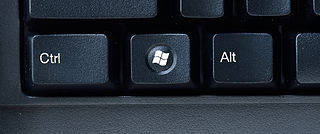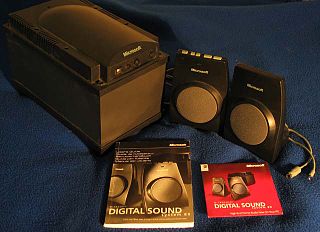The keyboard for IBM PC-compatible computers is standardized. However, during the more than 30 years of PC architecture being frequently updated, many keyboard layout variations have been developed.

Wake-on-LAN is an Ethernet or Token Ring computer networking standard that allows a computer to be turned on or awakened from sleep mode by a network message.
ACCESS.bus, or A.b for short, is a peripheral-interconnect computer bus developed by Philips and DEC in the early 1990s, based on Philips' I²C system. It is similar in purpose to USB, in that it allows low-speed devices to be added or removed from a computer on the fly. While it was made available earlier than USB, it never became popular as USB gained in popularity.

Apple Desktop Bus (ADB) is a proprietary bit-serial peripheral bus connecting low-speed devices to computers. It was introduced on the Apple IIGS in 1986 as a way to support low-cost devices like keyboards and mice, allowing them to be connected together in a daisy chain without the need for hubs or other devices. Apple Desktop Bus was quickly introduced on later Macintosh models, on later models of NeXT computers, and saw some other third-party use as well. Like the similar PS/2 connector used in many PC-compatibles at the time, Apple Desktop Bus was rapidly replaced by USB as that system became popular in the late 1990s; the last external Apple Desktop Bus port on an Apple product was in 1999, though it remained as an internal-only bus on some Mac models into the 2000s.

The Windows logo key is a keyboard key which was originally introduced on Microsoft's Natural Keyboard in 1994. This key became a standard key on PC keyboards. In Windows, pressing the key brings up the start menu. Ctrl+Esc performs the same function, in case the keyboard lacks this key.
A human interface device or HID is a type of computer device usually used by humans that takes input from or provides output to humans.
The Command key, ⌘, formerly also known as the Apple key or open Apple key, is a modifier key present on Apple keyboards. The Command key's purpose is to allow the user to enter keyboard commands in applications and in the system. An "extended" Macintosh keyboard—the most common type—has two command keys, one on each side of the space bar; some compact keyboards have one only on the left.

A handheld personal computer (PC), typically built around either a clamshell form factor or a gaming form factor with a gamepad integrated for video games, is a mobile device that is significantly smaller than any standard personal computer (PC), but based on the same principles as PCs. The clamshell form factor is sometimes referred to as a palmtop computer, not to be confused with Palmtop PC which was a name used mainly by Hewlett-Packard.
The Start menu is a graphical user interface element that has been part of Microsoft Windows since Windows 95, providing a means of opening programs and performing other functions in the Windows shell. The Start menu, and the Taskbar on which it appears, were created and named in 1993 by Daniel Oran, a program manager at Microsoft who had previously collaborated on great ape language research with the behavioral psychologist B.F. Skinner at Harvard.

Apple Inc. has designed and developed many external keyboard models for use with families of Apple computers, such as the Apple II, Mac, and iPad. The Magic Keyboard and Magic Keyboard with Numeric Keypad designed to be used via either Bluetooth and USB connectivity, and have integrated rechargeable batteries; The Smart Keyboard and Magic Keyboard accessories for iPads are designed to be directly attached to and powered by a host iPad. All current Apple keyboards utilize low-profile key designs, and common modifier keys.

The Apple Wireless Keyboard is a wireless keyboard built for Macintosh computers and compatible with iOS devices. It interacts over Bluetooth wireless technology and unlike its wired version, it has no USB connectors or ports. Both generations have low-power features when not in use. It was discontinued on October 13, 2015, and was succeeded by the new Magic Keyboard.

The Apple Adjustable Keyboard is an ergonomic keyboard introduced by Apple Computer, Inc. in 1993 for the Macintosh family of personal computers. The keyboard attaches to the computer via the Apple Desktop Bus port. The last Apple computer released compatible with this keyboard without using a USB to ADB adapter was the Power Macintosh G3, as it was the last one with the Apple Desktop Bus.

The Apple–Intel architecture, or Mactel, is an unofficial name used for Macintosh personal computers developed and manufactured by Apple Inc. that use Intel x86 processors, rather than the PowerPC and Motorola 68000 ("68k") series processors used in their predecessors or the ARM-based Apple silicon SoCs used in their successors. As Apple changed the architecture of its products, they changed the firmware from the Open Firmware used on PowerPC-based Macs to the Intel-designed Extensible Firmware Interface (EFI). With the change in processor architecture to x86, Macs gained the ability to boot into x86-native operating systems, while Intel VT-x brought near-native virtualization with macOS as the host OS.
Compared with previous versions of Microsoft Windows, features new to Windows Vista are very numerous, covering most aspects of the operating system, including additional management features, new aspects of security and safety, new I/O technologies, new networking features, and new technical features. Windows Vista also removed some others.
The Windows shell is the graphical user interface for the Microsoft Windows operating system. Its readily identifiable elements consist of the desktop, the taskbar, the Start menu, the task switcher and the AutoPlay feature. On some versions of Windows, it also includes Flip 3D and the charms. In Windows 10, the Windows Shell Experience Host interface drives visuals like the Start Menu, Action Center, Taskbar, and Task View/Timeline. However, the Windows shell also implements a shell namespace that enables computer programs running on Windows to access the computer's resources via the hierarchy of shell objects. "Desktop" is the top object of the hierarchy; below it there are a number of files and folders stored on the disk, as well as a number of special folders whose contents are either virtual or dynamically created. Recycle Bin, Libraries, Control Panel, This PC and Network are examples of such shell objects.

The Digital Sound System 80, short DSS80, was a three-piece PC audio system co-developed by Microsoft and Philips. It debuted on the 1998 Electronic Entertainment Expo (E³) and is most likely the only speaker system ever released by the Microsoft Corporation. It also remains one of the very few featuring Philips' wOOx subwoofer technology.

To shut down or power off a computer is to remove power from a computer's main components in a controlled way. After a computer is shut down, main components such as CPUs, RAM modules and hard disk drives are powered down, although some internal components, such as an internal clock, may retain power.
A legacy-free PC is a type of personal computer that lacks a floppy or optical disc drive, legacy ports, and an Industry Standard Architecture (ISA) bus. According to Microsoft, "The basic goal for these requirements is that the operating system, devices, and end users cannot detect the presence of the following: ISA slots or devices; legacy floppy disk controller (FDC); and PS/2, serial, parallel, and game ports." The legacy ports are usually replaced with Universal Serial Bus (USB) ports. A USB adapter may be used if an older device must be connected to a PC lacking these ports. According to the 2001 edition of Microsoft's PC System Design Guide, a legacy-free PC must be able to boot from a USB device.
The transition from Windows 7 to Windows 8 introduced a number of new features across various aspects of the operating system. These include a greater focus on optimizing the operating system for touchscreen-based devices and cloud computing.

The Surface Studio is an all-in-one PC, designed and produced by Microsoft as part of its Surface series of Windows-based personal computing devices. It was announced at the Windows 10 Devices Event on October 26, 2016, with pre-orders beginning that day.













